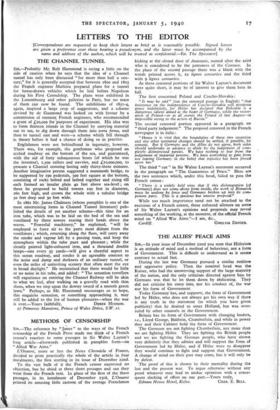LETTERS TO THE EDITOR
[Correspondents are requested to keep their letters as brief as is reasonably possible. Signed letters are given a preference over those bearing a pseudonym, and the latter must be accompanied by the name and address of the author, which will be treated as confidential.—ED. The Spectator]
THE CHANNEL TUNNEL
SIR,—Probably Mr. Rolt Hammond is erring a little on the side of caution when he says that the idea of a Channel tunnel has only been discussed " for more than half a cen- tury," for it is generally accepted that between 1800 and 1803 the French engineer Mathieu prepared plans for a tunnel for horse-drawn vehicles which he laid before Napoleon during his First Consulship. The plans were exhibited in the Luxembourg and other galleries in Paris, but no trace of them can now be found. The exhibitions of 1851-4, again, inspired a large crop of suggestions, and a scheme devised by de Gaumond was looked on with favour by a commission of eminent French engineers, who recommended a grant of £20,000 for purposes of experiment. His idea was to form thirteen islands in the Channel by carrying material out to sea, to dig down through them into terra firma, and then to tunnel east and west—a scheme which fell through in theory before it had a chance of doing so in practice.
Englishmen were not behindhand in ingenuity, however. There was, for example, the gentleman who proposed an arched roadway on the bottom of the sea, and guaranteed, with the aid of forty subaquaeous boats (of which he was the inventor), 1,500 sailors and navvies, and kro,o0o,000, to procure a Channel crossing lasting only thirty-three minutes. Another imaginative person suggested a mammoth bridge, to be supported by 190 pedestals, 300 feet square at the bottom, consisting of rocks bolted and lashed together and rising till each formed an insular plain 4o feet above sea-level ; on these he proposed to build towers too feet in diameter, 26o feet high, and crown the whole with a tubular bridge 5o feet deep and 3o feet wide.
In 1861 Mr. James Chalmers (whose pamphlet is one of the most entertaining items in Channel Tunnel literature) pub- lished the details of yet another scheme—this time for an iron tube, which was to be laid on the bed of the sea and ventilated by three towers rearing their heads above the waves. " Powerful machinery," he explained, " will be employed to force air to the parts most distant from the ventilators ; which, returning along the flues, will carry away the smoke and vapour left by a passing train, and keep the atmosphere within the tube pure and pleasant ; while the cleanly painted light-coloured iron, and a thousand double lamps—one every 35 yards—will give a cheerful aspect to this ocean roadway, and render it an agreeable contrast to the noise and damp and darkness of an ordinary tunnel, or even, the miles of uninviting scenery that often meet the eye in broad daylight." He maintained that there would be little or no noise in his tube, and added : " The sensation travellers will experience on entering the Channel Railway will be akin to what we feel, after walking on a gravelly road with thin shoes, when we step upon the downy sward of a smooth green lawn." Perhaps, as Mr. Hammond encourages us to hope, this exquisite sensation, or something approaching it, may still be added to the list of human pleasures—when the war


































 Previous page
Previous page